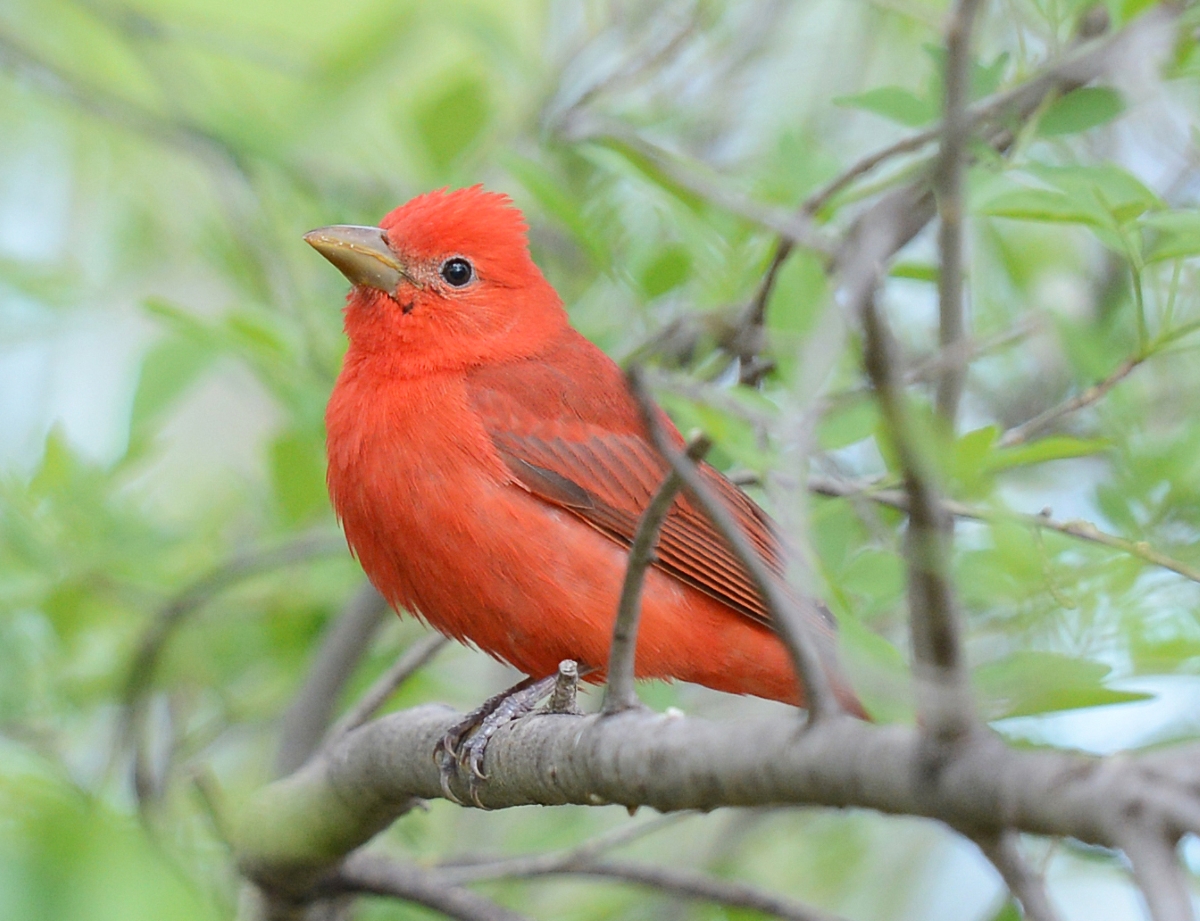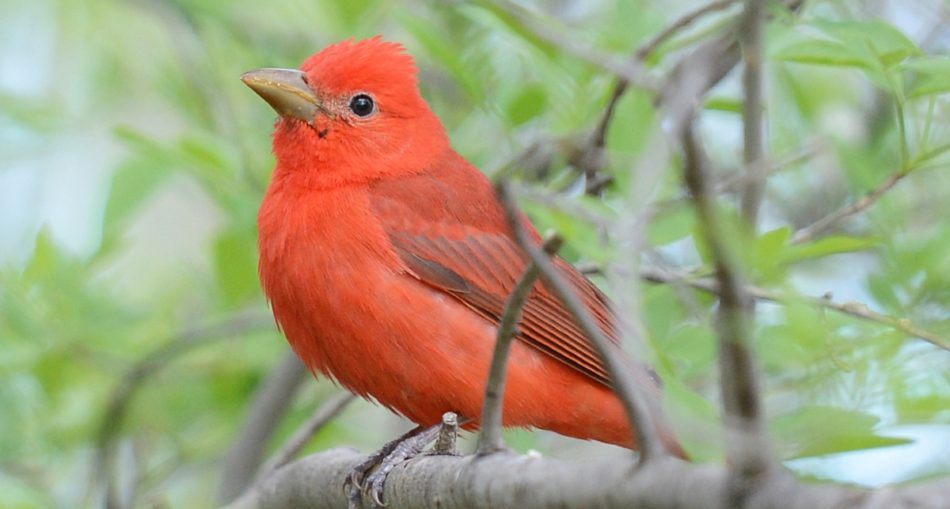You can find these brilliant orange coloured beauties flitting about forested areas. The Summer Tanager gets their striking and attractive orange hue from their unique diet. The Summer Tanager is native to the United States but migrates to Mexico, Central America and South America and has been spotted in Bolivia, Brazil and Guyana. The scientific name of the Summer Tanger is Piranga rubra, of which there are two (2) subspecies, namely Piranga rubra cooperi and Piranga rubra rubra. The male and female Summer Tanager looks different; males are orange and females are a mixture of orange and olive. You can distinguish the songbird by its sharp, “pi-tuk or pik-i-tuk-i-tuk” call.

The Summer Tanager – Photo By VJAnderson – Own work, CC BY-SA 4.0, https://commons.wikimedia.org/w/index.php?curid=83380551
Description Of The Summer Tanager
Colour – Male adult Summer Tanagers are rose-red while their female counterparts have orangeish underparts and olive backs, wings and tails.
Bill – The birds have a stout and pointed bills.
Weight & Height – The Summer Tanager is about seventeen (17) cm in length and twenty-nine (29) g in weight. Their wingspan ranges from twenty-eight to thirty (28-30) cm.
Call Notes – The sound of the Summer Tanager is sharp, almost agitated sounding like pi-tuk or pik-i-tuk-i-tuk.
Scientific Classification Of The Summer Tanager
Summer Tanager – Piranga rubra [Scientific name]
- Kingdom: Animalia
- Phylum: Chordata
- Class: Aves
- Order: Passeriformes
- Family: Cardinalidae
- Genus: Piranga
- Species: P. rubra
Habitat Of The Summer Tanager
The habitat of the Summer Tanager includes open woodlands and wooded areas with a mixture of oak and hardwood trees. In Mexico and the Americas, Summer Tanagers lives in humid evergreen and tropical deciduous forests.
Diet Of The Summer Tanager
The Summer Tanagers eats a wide variety of flying and non-flying insects including dragonflies, grasshoppers, beetles, ants, spiders and caterpillars. However, a larger part of their diet consists of bees and wasps. The birds also eat citrus fruits, berries like blackberries, bananas, whortleberries, and mulberries.
Reproduction Of The Summer Tanager
The Summer Tanager are serially monogamous and while they keep one mate per seasons, it is not necessarily the same for the rest of seasons. The male Summer Tanagers burst into full song, a few days before the females arrive on the breeding ground. Courtship including spirited chases by the male of the female then occurs. Sometimes the male will carry food items and hop about.
The species breeds once per year and begin building nests about two to four (2-4) weeks after arrival on the breeding ground. Nests are built by the female on horizontal branches about two point five to ten point five (2.5-10.5) m above ground. These are typically made of dry herbaceous vegetation, and lined with all sorts of fine grasses.
Soon after the nest is built, three to four (3-4) smooth and glossy eggs are laid and subsequently incubated for about two (2) weeks or twelve to thirteen days (12-13). While eggs are solely incubated by the female, the male helps with feeding by indirectly giving food to the female. The hatchlings leave the nest after eight to ten (8-10) days and by the end of ten (10), they can do short flights.
10 Interesting Facts About The Summer Tanager
- Summer Tanagers often attack wasps nests to scare away the wasps so they can eat the larvae.
- The bird prefers to forage in treetops to catch the unsuspecting bee or wasp.
- After catching the prey, the Summer Tanager carries it to a perch and slams it into until it dies. This removes the dangerous stingers and rest of inedible body parts.
- While the Summer Tanagers are typically found in areas of low elevations, they reach as high as one thousand eight hundred (1800) m in Panama.
- Breeding pairs are formed on the breeding grounds and part ways after the young leave the nest.
- The male Summer Tanager may accompany its mate to find a nesting site and building materials but will not help in building the nest.
- Summer Tanagers in the eastern range generally builds haphazard nests while that of those in the western range are skillfully constructed.
- Both parents clean the nests by removing the faecal sacs during the nestling stage.
- Young Summer Tanagers are fed whole food, but also some regurgitated food.
- The adult Summer Tanagers takes care of their young for up to two to four (2-4) weeks after fledging.
About The Summer Tanager
Similar to the Blue-gray Tanager or the Blue Saki, the Summer Tanager is a medium-sized songbird, easily recognized by its orange plumage. However, females are more yellowish with olive undertones. The bird is native to the United State but migrates southwards during winter to countries like Mexico, Guyana and Brazil. It’s a rare sight to see in Guyana so count yourself lucky if you do!
Article Reference
- https://en.wikipedia.org/wiki/Summer_tanager
- https://animaldiversity.org/accounts/Piranga_rubra/
- https://avibase.bsc-eoc.org/checklist.jsp?region=GY
- https://www.birdsofcolombia.org/guyana/Piranga.html







